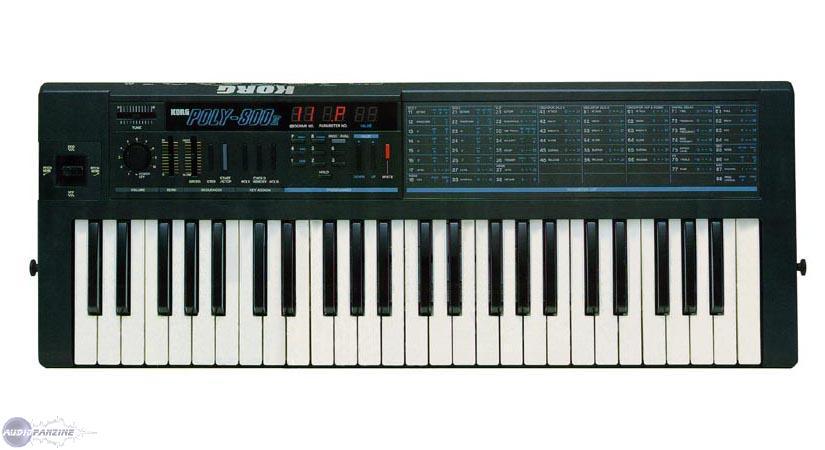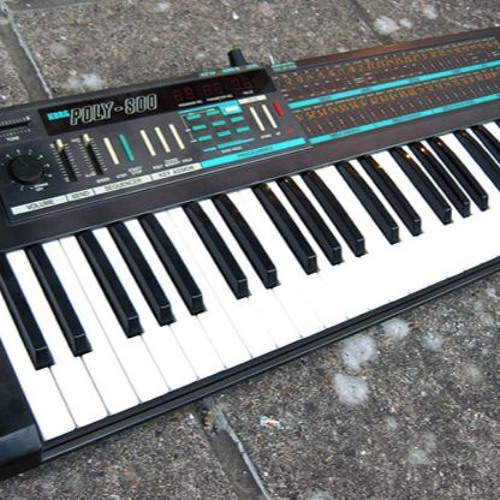

- #Korg poly 800 synthesizers generator#
- #Korg poly 800 synthesizers manual#
- #Korg poly 800 synthesizers full#
With a light-weight plastic case (only 10 lb.), a couple low-profile sliders/knobs and only 49 keys, the Poly-800 can run on batteries and has guitar strap pegs so it can be worn like a keytar. Unlike the Juno, which was still a “studio” instrument, the Poly-800 was built for the performer. ABOUT mobile live-Synth, pseudo-polyphonic because all voices have only ONE filter, well you can use it with batteries and it has complex envelopes, using 2.
#Korg poly 800 synthesizers generator#
There's also a stereo chorus effect, chord memory, a simple built-in sequencer, three digital envelope generators (for the oscillators, the noise generator and the filter), and a funky joystick used to adjust the pitch, modulation and the filter. The Korg Poly-800 is a 49 key (48 voice polyphonic) synthesizer, featuring dual oscillators (additive square waveform, single oscillator in 8 voice mode).

The analog filter is a 24dB/oct low-pass which is shared by all voices (the Juno has separate filter chips for each voice). There are 2 versions: mk1 with chorus and updated Mk2 (poly-800 II). The Poly-800 is an eight-voice instrument (two more than the Juno series) with 64 memory patches (half of what the Juno-106 offered) and up to 50 editable parameters! Like the Juno, the Poly-800 had one DCO per voice, although it did feature a Double mode in which the oscillators could be stacked up for a fuller sound and only four voices of polyphony. Affordable polysynth based on DCO oscillators and internal sequencer. The Poly-800 was comparable to the Juno-106, at the time, with respect to the fact that musicians now had access to affordable programmable polyphonic analog synthesizers (it listed for under $1,000) with memory storage, stable DCOs (digitally controlled oscillators) and a new state-of-the-art technology called MIDI (although there was no SysEx implementation yet). Sound Tape included.Īt a time when Roland was doing well with their Juno-series, KORG countered with a poly-synth of their own in 1983 with the Poly-800. Text, review, special demos copyright polynominal.Works as it should. Sound is sometimes unusual with many sonic artefacts resulting pretty harsh, that may looks interesting.

"Classic analog budget: some nice pads and sweeps. Your browser does not support the audio element. Mk2 handles Sysex and features a Cr-2032 battery While 150 is a good price for it, I would still not get one again since I ended up using it so. Tbf, mine didnt have the moog slayer mod, which probably adds a lot to the playability of it. The chip is a resonant (but not self-resonant) analog 4 poles lowpass with cutoff, contour and possible polarity reverse.Ī very basic 256 steps sequencer with external Midi clock sync The Poly 800 is easily the least fun vintage synth I owned - it is cumbersome to program, has really low parameter resolution and the keybed felt awful.

#Korg poly 800 synthesizers full#
whole mode: 1 x 8 voices for full polyphonyĪn oscillator features 2 summable waveforms sawtooth and square plus 4 additive harmonic octaves heights at 16' 8' 4' 2' and a white noice generator.Ī limited paraphonic filter based on a single NJM2069. double mode: 2 x 4 voices for a thicker richer sound 64 custom patches for the Korg Poly-800, including a variety of pads, retro sounds, basses, sequencer sounds and funky leads. Main panel features a segmenst display, 3 sliders, 19 button and 1 data slider.Ĩ digitally controlled oscillators assignable in 2 different manners:
#Korg poly 800 synthesizers manual#
There are 2 versions: mk1 with chorus and updated Mk2 (poly-800 II) with digital delay, Midi Sysex and battery memory system.ĭOWNLOAD: user manual mk1 - user manual mk2 - factory patch mk1 (wav) - factory patch mk2 (syx) Affordable polysynth based on DCO oscillators and internal sequencer.


 0 kommentar(er)
0 kommentar(er)
